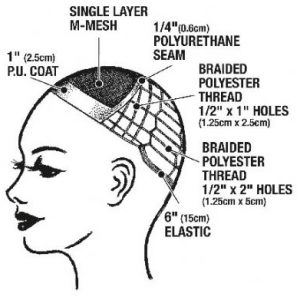
If you are concerned with hair loss or its prevention, you are not alone. In Europe approximately $1 billion dollars has been spent on preventing or treating hair loss1. This number jumps to approximately $2.2 billion dollars in the USA1.
Hair systems (this can include wigs as well as other non-surgical hair replacement options) are commonly used by individuals who have medical conditions that cause hair loss. Some examples can include individuals who struggle with trichotillomania as well as patients undergoing chemotherapy2. Using hair systems have actually increased self-esteem in women who struggle with alopecia areata (N=49)3.
There are quite a few options you can use to conceal hair loss. Today we are going to examine just two of the many non-surgical hair replacement options available at Sure Hair International; cranial prosthesis and hair integration systems. Cranial prosthesis can either be a full piece, covering the whole head, or it can be a partial piece. This prosthesis can allow your scalp to show through, making the hair system look more natural4. This type of hair system can be trimmed to specifically fit you, avoiding the need to remove the piece before any water activity (e.g., swimming, showering etc.) like other hair systems4. This type of prosthesis also contains a specially designed foundation that can have hair easily inserted and locked into place without the need for knots. Knots are traditionally used to keep the hairs attached to the foundation making the hair bulky and unnatural looking4.
There are some downsides however with this type of hair system. Cranial prostheses are not available at all retail outlets and they are more expensive than traditional synthetic hair systems4. In order for the prosthesis to remain on the scalp, medical adhesives (e.g., medical glue) needs to be applied on the head4. Oil and sweat can influence proper attachment of the prostheses4. However, with medical adhesives we have available at Sure Hair International, athletes, active individuals and those that perspire more often can enjoy cranial prostheses as well.
Hair integration systems are another option to consider. They involve adding synthetic or human hair to balding areas. This system is more natural looking and is custom made for you4. The color of the hair used can be hand matched to blend with your natural hair. 4 This hair system is not for everyone. Hair loss needs to be localized in order to successfully use this system4.
The key to wearing a hair system is skill, knowledge and effort5. Information, support, coloring and styling can be supplied from hair care professions such as Sure Hair International (located in Toronto, London, and Hamilton, Ontario). Don’t be afraid to come in and ask about what system would work best for you.
Article by: Sarah Versteeg MSc, Mediprobe Research Inc.
- Rushton DH, Norris MJ, Dover R, Busuttil N. Causes of hair loss and the developments in hair rejuvenation. Int J Cosmet Sci. 2002 Feb;24(1):17–23.
- van den Hurk CJG, van den Akker-van Marle ME, Breed WPM, van de Poll-Franse LV, Nortier JWR, Coebergh JWW. Impact of scalp cooling on chemotherapy-induced alopecia, wig use and hair growth of patients with cancer. Eur J Oncol Nurs Off J Eur Oncol Nurs Soc. 2013 Oct;17(5):536–40.
- Inui S, Inoue T, Itami S. Psychosocial impact of wigs or hairpieces on perceived quality of life level in female patients with alopecia areata. J Dermatol. 2013 Mar;40(3):225–6.
- Banka N, Bunagan MJK, Dubrule Y, Shapiro J. Wigs and hairpieces: evaluating dermatologic issues. Dermatol Ther. 2012 Jun;25(3):260–6.
- Goffman E. The Presentation of Self in Everyday Life. Doubleday: Anchor Books; 1959.












